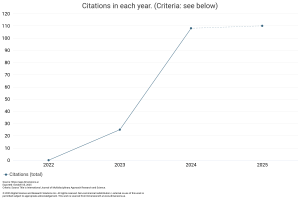Time in T.S. Eliot’s “Four Quartets: Burnt Norton”
DOI:
https://doi.org/10.59653/ijmars.v3i03.1887Keywords:
temporarility, symbolic, poem, constraint, memory, quartetsAbstract
The significance of time in Eliot’s “Four Quartets: Burnt Norton” is examined in this paper. Particular attention should be paid to “Burnt Norton,” the opening section of Eliots “Four Quartets”. This study examines Eliot’s treatment of temporality as a structural and thematic principle in contrast to previous scholarship that approached the Quartets through themes of music, dance, liturgy love, and salvation. I contend that Eliot views time as cyclical rather than linear with the past present and future constantly interacting to produce transcendental moments. Through recollection imagination and symbolic imagery like the rose garden echoes children’s laughter and the still point time is revealed in Burnt Norton as irredeemable yet essential. Speculative abstraction imaginative reconstruction ecstatic moments of stillness recognition of emptiness and reconciliation through words music and silence are the five movements that explore the interplay between temporality and timelessness in this poem. Through his engagement with Heraclitus, Heidegger Bergson, and Neoplatonic ideas Eliot positions time as a constraint as well as a window into eternity. Burnt Norton, the study concludes, enacts a paradoxical synthesis: temporal existence is unavoidable but the possibility of timeless order and meaning only arises through the memory of fleeting moments.
Downloads
References
Balakrishnan, P. (1991). An Indian View of T. S. Eliot’s Four Quartets. The American Scholar, 60(1), 73-89.
Bergson, H. (1950). Time and Free Will, Translated by F. L. Pogson, George Allen and Un-win Limited.
Blamires, H. (1969). Word Unheard: A Guide through Eliot’s ‘Four Quartets’, Methuenand Company Limited.
Boaz, M. M. (1979). Aesthetic Alliances in Poetry and Music: T. S. Eliot’s ‘Four Quartets’ and ‘String Quartets’ by Bela Bartok.The Journal of Aesthetic Education, 13(3),31-49.
Dallas, E. S. (1965). Canon Cancrizans and the Four Quartets”, 3, 192-208.
Eliot, T. S. Four Quartets, Harcourt, 1941.
Eliot, T. S..“Traditions and the Individual Talent.” Critical Thinking Since Plato, Edited by Hazard Adams, New York: Harcourt Brace Jovanovich, 1992, pp. 760-764.
Gardner, H. (1992). The Composition of Four Quartets, New York: Oxford University Press.
Gross, H. (1959). Music and the Analogue of Feeling: Notes on Eliot and Beethoven. The Centennial Review of Arts and Science, 3(3), 269-288.
Heidegger, M. (1996). Being and Time, Translated by Joan Stambaugh, State University of New York Press.
Heraclitus. (1969). Heraclitus of Ephesus: An Edition Combining in One Volume the Frag-ments of the Work of Heraclitus of Ephesus on Nature, translated from the Greek text of Bywater with Introduction and Critical Notes by G. T. W. Patrick; and Heracliti Ephesii Reliquiae, ed I. Bywater, with an Introduction and Select Bibliography by Lewis A. Richards; The Argonaut Library of Antiquities, Chicago: Argonaut, Inc.
Hough, G. (1973). ‘Vision and Doctrine in Four Quartets.’ Critical Quarterly, xv(2), 107-128.
Jones, S. (2009). “‘At the still point’: T. S. Eliot, Dance, and Modernism,” Dance Research Journal, 41(2), 31-51.
Julian of Norwich. (1949). Revelations of Divine Love, ed. Grace Warrack, 13th ed. London: Metheun & Co., Ltd.
Lepecki, A. (2000). “Still: On the Vibratile Microscopy of Dance.” In Remembering the Body, edited by Gabriele Brandstetter and Hortensia Volckers, Ostfildern-Ruit: Hat-jeCantz, 334-64.
Matthiessen, F.O. (1943). Eliot’s Quartets. The Kenyon Review, 5(2),178.
Moses, O. (2005). AFFECTING TIME: T. S. Eliot’s ‘Burnt Norton’, An Interdisciplinary Journal, 88(½), 129-151.
Plotinus. (1895). Selected Works of Plotinus, trans. Thomas Taylor, ed. G. R. S. Mead, New York: G. Bell & Sons, pp. 180.
Rees, T. R. (1969). The Orchestration of Meaning in T. S. Eliot’s Four Quartets, The Jour-nal of Aesthetics and Art Criticism, 28(1), 63-69.
Sherma, A. B. (2023). Anarchy, Militancy, Transactional Sex and Homo Sacer in Samar Yazbek’s The Crossing: My Journey to the Shattered Heart of Syria. American Jour-nal of Arts and Human Science, 2(4), 37–45. https://doi.org/10.54536/ajahs.v2i4.2234
Stanwood, P. G. (1979). Time and Liturgy in Donne, Crashaw, and T. S. Eliot. An Interdis-ciplinary Critical Journal, 12(2), 91-105.
Weatherhead, A. K. (1962). Four Quartets: Setting Love in Order. Wisconsin Studies in Con-temporary Literature, 3(2), 32-49.
Weitz, M. (1952). T. S. Eliot: Time as a Mode of Salvation. The Sewanee Review, 60(1), 48-64.
Downloads
Published
How to Cite
Issue
Section
Categories
License
Copyright (c) 2025 Milina Tamrakar

This work is licensed under a Creative Commons Attribution-ShareAlike 4.0 International License.
Authors who publish with this journal agree to the following terms:
- Authors retain copyright and grant the journal right of first publication with the work simultaneously licensed under a Creative Commons Attribution-ShareAlike that allows others to share the work with an acknowledgement of the work's authorship and initial publication in this journal.
- Authors are able to enter into separate, additional contractual arrangements for the non-exclusive distribution of the journal's published version of the work (e.g., post it to an institutional repository or publish it in a book), with an acknowledgement of its initial publication in this journal.
- Authors are permitted and encouraged to post their work online (e.g., in institutional repositories or on their website) prior to and during the submission process, as it can lead to productive exchanges, as well as earlier and greater citation of published work (See The Effect of Open Access).
























